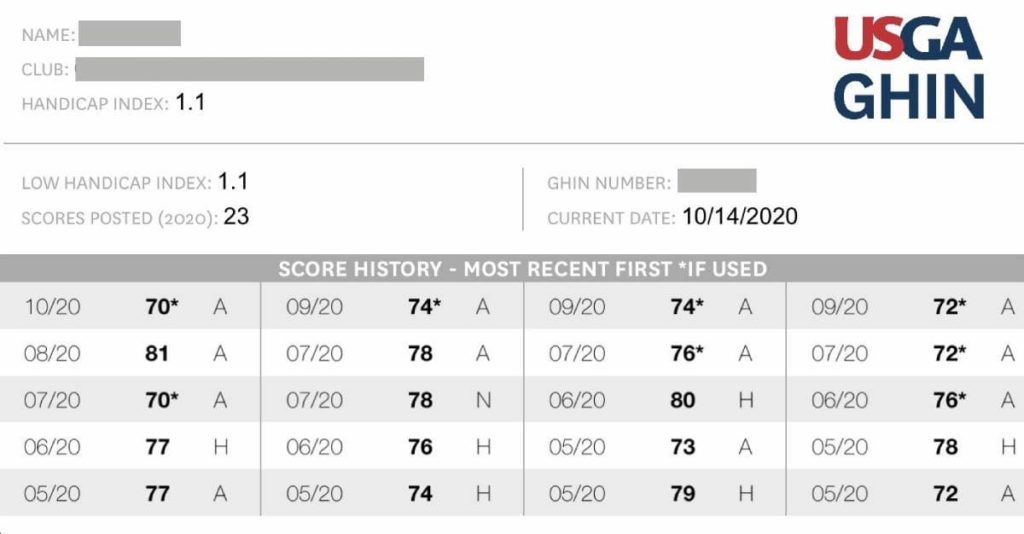A golf handicap is a system to measure what level of a golfer you are so you can measure your performance and compete against other golfers at the same playing field regardless of ability. You will acquire a number called a Handicap Index supported by the United States Golf Association and also given a Golf Handicap Information Network (GHIN) number which identifies you in the USGA.
How Do You Establish a USGA Handicap?
A handicap can be established at a local golf club or through a regional or state association that governs golf in your area. The USGA allows these associations to calculate your handicaps.
To be clear, a golf club not only is an actual golf course but can be a club that exists with members, by-laws, committees that oversees golf activity, provides access to peer review and to maintain the integrity of legitimate handicap indexes. These clubs and your local golf courses operate under the golf associations. These associations also determine when your handicap index revises either it be twice a month or daily.
Here is a list of USGA association partners that you can find in your area that can lead you to your preferred club or golf course.
How Do You Calculate Your USGA Handicap
Fortunately, you don’t have to calculate this on your own, the USGA has calculators to help you do that.
- Play a minimum of 5 rounds. Please note the golf course you played at during each round
- List your 5 most recent rounds into the USGA Golf Handicap Calculator
- The USGA has a numerical formula that calculates the scores of your last 20 rounds. Without going over the full details, it’s close to the average over par you shoot for your golf rounds. The course difficulty is also a factor using the slope and rating of that golf course and the tees you played from
- The course difficulty is also a factor using the slope and rating of that golf course and the tees you played from. That’s why I mentioned earlier to be sure to keep track of the courses you played. You will need to enter each golf course into the system
How Do You Enter Your Scores
After playing and shooting an 18 hole score, you are to input your scores into your regional or state association handicap system. You can usually enter scores into a handicap computer at any golf course but these days, you can download the association’s app or enter it in on their website.
If you played the home course you selected to represent, the input page should default to that course when you enter the scores. If you played a different course or trying to input your score at different course, you will need the following info
- Score
- Date played
- Find Course in a provided database / Tees played
- Slope and Rating from tees played if you are not able to find the course in a provided course database.
The World Handicap System (WHS) has a guideline of a maximum score of what you can enter. You can only enter Net Double Bogey or lower on any holes. This means that if you are getting a stroke(s) for that hole, you can only use that score after the strokes are given and double bogey would be the maximum score to use for handicap purposes.
If you got a stroke on a hole and you scored an 8 on a Par 4, you are only allowed to score a 7 when you are to total your hole scores so if that was your only hole that exceeded net double bogey, you are supposed to input one less stroke off of your total score into your handicap system.
How Do You Use Your Handicap When Playing
The Handicap Index is the official rating for you as a golfer. You will use that number and convert it to a Course or Playing Handicap so you can figure out what strokes are given or received when competing against others. There usually is a conversion chart by the handicap computer at each golf course. The charts are specifically calculated for each course depending on the slope and rating of that course and tees being played from.
First you will have to convert your index number to the course handicap. Depending on the difficulty of the course and tees played from, you will then use a rounded-off number. If you are to play a very difficult course and you have a 14.3 handicap, there is a good chance that your handicap for that day will be 16 or 17. This means that you are expected to shoot 90 or 91 on a Par 72 course. So your goal is to try and play better than that.
Related: Here is a link to a USGA calculator where you can convert your handicap index to your course handicap.
You can either use the handicap for yourself and see if you can shoot better than your handicap or use it to play other golfers starting on a level playing field.
How a Golf Handicap Factors into Games
There are many games to be played against other golfers but you would still start with converting your handicap index to your course handicap. From there, you take the difference of the handicaps among the opponent and whichever is higher, will get the difference of strokes on the hardest handicap holes that are labeled on the scorecard.
Examples of a one-on-one game: John is 5.8 index, he converts his index to that course and tees played from using his Golf Association app and now has a 7 course handicap. Bob is a 10.7 index and he converts it to a 13 course handicap. So the difference is 6.
If they are to compete against each other in Stroke play (link to Golf games to play), Bob will be getting 6 strokes so John will need to beat Bob by 7 total strokes if he is to win. In Match Play, the 6 strokes will be spread out to each of the 6 hardest holes that are on the scorecard so John will need to beat Bob by a stroke on those holes just to tie him.
What Do Slope and Rating Mean?
Not to bore you with analytics and formulas but I will speak with all the simplest terms to explain this. The USGA assigns these numbers to the course with different numbers when using all the tees offered to show the difficulty of the course.
Course rating tells Scratch golfers how difficult the course is by assigning a number relative to par on that golf course. So if the par is 72 and the course rating is 72.9, that scratch golfer is probably expecting to shoot possibly 73. If it’s 70.1, that golfer is expected to shoot 70.
Slope rating tells Bogey golfers how difficult the course is by a number they used relative to the course rating. It ranges from 55-155. The average was set at 113 but with courses challenging golfers more in recent years, the average is a little higher now.
So one of the courses I teach at from the Pro Tees is 74.7 with a 133 slope. This means that if I were to play it, I would be expected to shoot 75 or less. If a golfer that has an 18 handicap or so, were to play it from the same tees, the golfer would definitely have difficulty shooting his average score.


